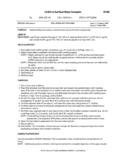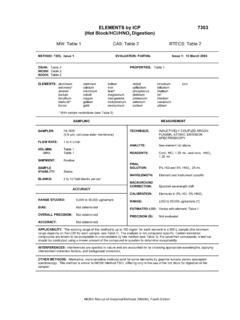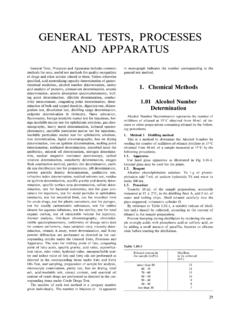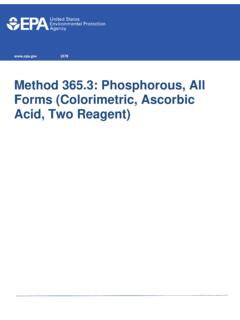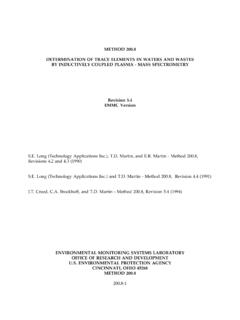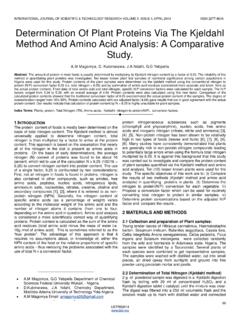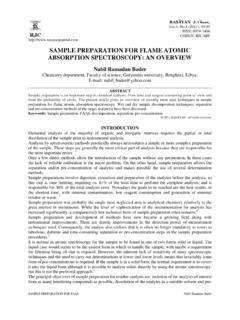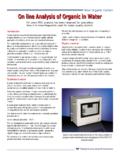Transcription of Determination of Total Cyanide in Municipal …
1 Application Note 227 Determination of Total Cyanide in Municipal Wastewater and Drinking Water Using Ion- exclusion chromatography with pulsed amperometric detection (ICE-PAD)INTRODUCTIONC yanide is a well known acute toxin that prevents cellular respiration by irreversibly binding with the iron in cytochrome C ,2 In addition, thiocyanate, which is metabolized from Cyanide , interferes with iodine uptake by the thyroid gland, causing goiters and other long-term iodine deficiency Cyanide is regulated as an environmental contaminant by the US EPA for drinking water, surface water, and wastewater due to these health 5 Total Cyanide is defined by the US EPA as free Cyanide ion and complex cyanides that are converted to hydrocyanic acid (HCN) during strong acid More recently, Total Cyanide also includes ferrocyanide and ferricyanide due to free Cyanide formed by exposure to For drinking and surface waters, the US EPA has established a maximum contamination level (MCL) of 200 g/L free Cyanide determined by a Total Cyanide To determine Total Cyanide , the sample is digested with sulfuric acid to convert the Cyanide to hydrogen Cyanide gas, aspirated into a strong caustic solution, then assayed.
2 In wastewater, the EPA specifies Cyanide discharge limits by industry and size of the facility (<38,000 or >38,000 liters per day).8 The typical sources of Cyanide contamination are industrial waste from plating and mining industries, burning coal and plastics, and effluent from publicly owned treatment works (POTW).1,2 The EPA specifies g/L Total Cyanide continuous discharge limits for POTW and 22 g/L maximum discharges into fresh ,5 For salt water bodies, the continuous and maximum discharges are 1 g/L Total Cyanide . The EPA defines these continuous (4 d) and maximum (1 h average) limits to ensure that aquatic life is percent of the Cyanide in POTW influent and flow-through are attributed to the metal finishing and organic chemical However, many POTWs report that Cyanide concentrations in wastewater effluents are higher than those from the influent Cyanide concentrations as high as 60 g/L have been reported at discharge This Cyanide generation is associated with chlorination and chloramination processes used for waste ,10 Nitrate formed from chlorination of ammonium creates unstable intermediates that degrade to Cyanide during the harsh acid and temperature conditions typically used for acid-distillation in Total Cyanide determinations.
3 In EPA methods , , and , samples are individually acid- or UV-digested to convert all Cyanide compounds to hydrogen Cyanide gas which is distilled into sodium hydroxide (pH 13). Total Cyanide is then determined spectrophotometrically or by ,11,12 These methods are complicated, often requiring multiple distillation apparatuses, and they are subject to interference from high-pH solutions, oxidizers, and sulfur-containing chromatography methods, such as ion-exchange (IE) and ion- exclusion (ICE) can eliminate some of these interferences by separation. with IE chromatography , Cyanide is not fully 2 Determination of Total Cyanide in Municipal Wastewater and Drinking Water Using Ion- exclusion chromatography with pulsed amperometric detection (ICE-PAD)EXPERIMENTALE quipmentDionex ICS-3000 Ion chromatography system consisting of: Single Gradient Pump (SP) module with degas option Detector and chromatography Module (DC) with single or dual heating zone, and 6-port injection valve Electrochemical Detector ED (P/N 061718) AS Autosampler with Sample Tray Temperature Controlling option, and 10 mL sample tray An electrochemical cell containing a combination pH Ag/AgCl reference electrode (cell and reference electrode, P/N 061756) and a disposable (Pt) working electrode (P/N 064440 package of six) Chromeleon chromatography Workstation Vial Kit, 10 mL polystyrene with caps and septa (P/N 055058)Knitted reaction coil, 375 L, (P/N 043700) with two PEEK unions ( -28 thread female to 10-32 thread female, P/N 042806) MICRO DIST System for sample distillation (Lachat Instruments/Hach Company, P/N MDD001) with user filled tube kit (Hach Company, P/N A17117 package of 100)
4 , heating block, protective gloves, test tube racks, and a small mechanical unit for vacuum filtration, m nylon (Nalgene Media-Plus with 90 mm filter, Nalge Nunc International, P/N 164-0020) or equivalent nylon filter. Vacuum pump Syringe filter (Pall Life Sciences, GHP Acrodisc 25 mm with m GHP membrane, P/N 4560T) or filter unit for sample filtration, m nylon (Nalgene Media-Plus with 50 mm filter, Nalge Nunc International, P/N 153-0045) or equivalent nylon filter PEEK Tubing:Red ( mm or in , P/N 052310 for 5 ft) tubing used for liquid line connections from injection valve to the guard and analytical columns, and ( mm or in , P/N 052301 for 5 ft) tubing used for system backpressure L PEEK sample loop (P/N 042950)resolved from chloride and sulfide concentrations at mg/L levels. ICE is preferred because strong acid anions such as chloride and sulfate are excluded from the column, and Cyanide is resolved from sulfide.
5 Electrochemical detection by direct current (DC) amperometric , or pulsed amperometric detection (PAD), is sensitive, selective, and suitable for direct determinations of ,15 PAD is preferred over DC amperometry because in PAD the working electrode is cycled through three or four voltage potentials every second, resulting in an electrode surface which is continually cleaned, whereas in DC amperometry, the working electrode can foul over time, leading to a loss in peak In the previous PAD methods used to detect Cyanide , the silver working electrode also detected chloride and was incompatible with samples containing mg/L concentrations of Using PAD with a Pt working electrode, chloride is not detected, and the Pt working electrode is stable with mg/L sulfide concentrations. None of the previous ICE-PAD methods were used to determine 17 with this method, the authors combine the advantages of ICE with the sensitivity, selectivity, and stability of PAD using a Pt working electrode to directly detect Cyanide without interferences from chloride and sulfide.
6 In this Application Note, the authors describe a method with PAD using a Pt disposable working electrode and a waveform optimized for Determination of Total Cyanide in drinking and wastewater. Prior to analyses, the samples are acid distilled, trapped in 1 M NaOH, and diluted to 250 mM NaOH using the EPA-approved MICRO DIST sample preparation system. This ICE-PAD method has the advantages of eluting Cyanide before sulfide (Rs > 3) and excluding chloride and sulfate, which typically interfere in ion exchange methods. This ICE-PAD method provides a fast, reliable, sensitive, and selective method to directly determine g/L to sub- g/L concentrations of Total Cyanide in wastewater. The authors also demonstrate linearity, detection limits, accuracy, and precision for Determination of Total Cyanide in drinking water and wastewater samples using the MICRO DIST system and ICE-PAD.
7 Application Note 227 3 REAGENTS AND STANDARDSR eagents Deionized water, Type 1 reagent grade, M -cm resistivity, freshly degassed by ultrasonic agitation and applied only ACS reagent grade chemicals for all reagents and chloride, hexahydrate (VWR, P/N JT2444-1)Methanesulfonic acid (Aldrich, P/N 64280; Dionex, P/N 033478)pH 7 (yellow) buffer solution (VWR International, P/N BDH5046) pH 4 (red) buffer solution (VWR International, BDH5018) Sodium Cyanide , anhydrous (Aldrich, P/N 20,522-2)Sodium hydroxide, 50% (w/w) (Fisher Chemicals, P/N SS254-500)Sulfuric acid (VWR, P/N JT9681-33)For Interference ExperimentsAmmonium chloride (Aldrich, P/N 213330, FW )Sodium cyanate (Aldrich, P/N 185086, FW ) Sodium sulfide, nonahydrate, > (Aldrich, P/N 431648, FW )Sodium thiocyanate, (Aldrich, P/N 251410, FW )Sodium nitrate (Aldrich, P/N SS506, FW )Sodium sulfate (Aldrich, P/N 239313, FW )SamplesCertified Wastewater Standard for Cyanide , 40 g/L Total Cyanide (20 g/L free Cyanide from potassium Cyanide and 20 g/L complexed Cyanide from potassium ferricyanide in potassium hydroxide) (High-Purity Standards, P/N CWW-CN-D).
8 Municipal wastewater effluent samples were collected at the same time and location. Sodium hydroxide was added to one of the samples immediately after Municipal drinking water sample stabilized with 2 g of 50% sodium hydroxide per 250 mL of : IonPac ICE-AG1 Guard, 4 50 mm (P/N 067842) IonPac ICE-AS1 Analytical, 4 250 mm (P/N 064198)Flow Rate: mL/minEluent: 50 mM Methanesulfonic acidColumn Temperature: 30 CTray Temperature: 10 CInj. Volume: 50 LDetection: pulsed amperometric detection (PAD)Waveform: See Table Electrode: pH-Ag/AgCl electrode (P/N 061879) in AgCl modeWorking Electrode: Disposable PlatinumTypical Background: 70 120 nC Typical System Backpressure: 2200 psi Noise: 20 30 pCTypical pH: Time: 30 min Table 1: Cyanide detection Waveform Optimized for Acid Eluents17 Time (sec)Potential vs. Ag/AgCl (V)Gain + + + + (Start) + (End) + gain and ramp are instrument settings for the ICS-3000 IC electrochemical Determination of Total Cyanide in Municipal Wastewater and Drinking Water Using Ion- exclusion chromatography with pulsed amperometric detection (ICE-PAD)PREPARATION OF SOLUTIONS AND REAGENTSWhen preparing eluents, it is essential to use high quality, Type 1 water ( M -cm resistivity or better) that contains as little dissolved gas as possible.
9 Dissolved gases can cause higher noise levels. Degas the deionized water before eluent preparation using a Nalgene filter flask (P/N 164-0020) with m nylon filter with applied vacuum. Prepare 1 L of degassed Type 1 water weekly for the AS Autosampler flush solution. Preparation of Eluent To prepare 2 L of 50 mM methanesulfonic acid (MSA) eluent, pipette mL ( g) MSA (FW ) into a 2 L glass eluent bottle containing 1993 g of Type 1 degassed, deionized water. Immediately cap the bottle, connect it to the Eluent A line, and place the eluent under ~4 5 psi of helium or other inert gas. Thoroughly mix the eluent solution and prime the pump with the new eluent. Preparation of Standards Warning: Cyanide is a poison by inhalation, contact, and ingestion. Solutions containing Cyanide can generate hydrogen Cyanide gas at neutral or acidic pH, and must be stabilized with base.
10 Read and follow the material safety data sheet (MSDS) instructions for personnel handling, exposure, and disposal information. Consult local safety personnel for regulations concerning the proper disposal of Cyanide . Add 100 mL of 50% NaOH into the system waste container. Hydrogen Cyanide gas is created during the acid digestion of Cyanide -containing samples. Conduct the acid digestion sample preparation in a well-ventilated high quality, 50% (w/w) sodium hydroxide solution for diluent preparation. Sodium hydroxide pellets are coated with sodium carbonate and cannot be used for this application. Preparation of 100 mM Sodium Hydroxide DiluentTo prepare 250 mL of 100 mM sodium hydroxide (NaOH) diluent, pipette mL ( g) of 50% NaOH into a 250 mL HDPE bottle containing g degassed Type 1 deionized water. Swirl the bottle gently to thoroughly mix the solution. Use this solution as the diluent for all Cyanide standards.
